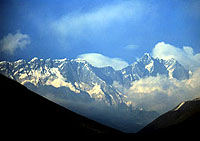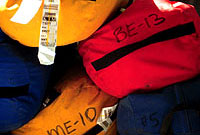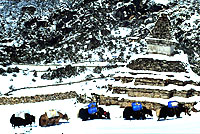 |
 |
 |
 The Approach March
The Approach Marchpart 2 | back to part 1 Preparation and Supplies Spirits are high as the team prepares to fly from the cacophony of Kathmandu's busy streets into the mountains. Click here to hear the sounds of Kathmandu (RealAudio 28K). This will be their final opportunity to buy last minute essentials and gear. Packing is a painstaking process because the contents of cases must be carefully itemized and then the bags must be separated. Some bags go to Base Camp (and won't be seen for up to 2 weeks), and some are flown 2 days ahead to a higher village. This is a hint of what's to come: a monumental effort of moving loads from point A to B by helicopter, Sherpa, and yak.  The amount of energy and forethought required to put together an expedition
with 12 members is overwhelming. Ed Viesturs and his wife Paula—who is the
expedition Base Camp manager—spent four months before the trip organizing
equipment and food for the expedition from their home in Seattle. "You can
imagine," says Ed, "to go shopping for yourself for a week is one thing, but to
go shopping for 12 people for 8 or 10 weeks is really hard. There are
different ways of doing it. Some people measure how many ounces of cereal they
eat in a morning, multiply that times the number of people and then times the
number of days. I thought that was a little too anal. So I just said 'okay 2
big boxes of cereal per week per group of 12 people'. I tried to make it a
little more simple. And sure maybe we'll run out of a few things but I think
we have more than enough." Click here to hear more from Ed about organizing an
expedition (RealAudio 105K).
The amount of energy and forethought required to put together an expedition
with 12 members is overwhelming. Ed Viesturs and his wife Paula—who is the
expedition Base Camp manager—spent four months before the trip organizing
equipment and food for the expedition from their home in Seattle. "You can
imagine," says Ed, "to go shopping for yourself for a week is one thing, but to
go shopping for 12 people for 8 or 10 weeks is really hard. There are
different ways of doing it. Some people measure how many ounces of cereal they
eat in a morning, multiply that times the number of people and then times the
number of days. I thought that was a little too anal. So I just said 'okay 2
big boxes of cereal per week per group of 12 people'. I tried to make it a
little more simple. And sure maybe we'll run out of a few things but I think
we have more than enough." Click here to hear more from Ed about organizing an
expedition (RealAudio 105K).The end result?—3 tons of gear, two thirds of which is food. In all, 249 loads of equipment, food, and gear must be transported to Base Camp on the backs of porters and yaks.  This translates into 47 film cases, 57 food cases,
30 climbing hardware and tent loads (with over 40 tents and 50 sleeping pads),
5 science cases, 50 cases of local food and supplies, 45 gallons of cooking
kerosene, 30 gallons of gasoline for the generator, 3000 feet of rope, 75
bottles of oxygen, and 300 rolls of toilet paper. We'll be a small army of 30
porters, 12 climbing Sherpas, a cook staff of 10, 12 yak herders, and 75
yaks. This translates into 47 film cases, 57 food cases,
30 climbing hardware and tent loads (with over 40 tents and 50 sleeping pads),
5 science cases, 50 cases of local food and supplies, 45 gallons of cooking
kerosene, 30 gallons of gasoline for the generator, 3000 feet of rope, 75
bottles of oxygen, and 300 rolls of toilet paper. We'll be a small army of 30
porters, 12 climbing Sherpas, a cook staff of 10, 12 yak herders, and 75
yaks.At the airport in Kathmandu, groups are shuttled from one corner to another, moving slowly in waves toward the planes that rarely arrive on time. Trekkers of all nationalities fuss over their packs. "It'll be great to finally get into the mountains," comments Araceli as we wait to fly out. An old MI-17 Soviet helicopter, a remnant from the Afghan War, is finally ready to lift off, and we're corralled into seats that line the sides of the iron behemoth. We throw our day packs on top of an already massive pile of duffles and supplies that occupy the center of the helicopter. The flight takes less than an hour and we step off the chopper in a daze, legs shaking and ears ringing. Welcome to the Khumbu. Click here for a map. Continue Lost on Everest | High Exposure | Climb | History & Culture | Earth, Wind, & Ice E-mail | Previous Expeditions | Resources | Site Map | Everest Home Editor's Picks | Previous Sites | Join Us/E-mail | TV/Web Schedule About NOVA | Teachers | Site Map | Shop | Jobs | Search | To print PBS Online | NOVA Online | WGBH © | Updated November 2000 |